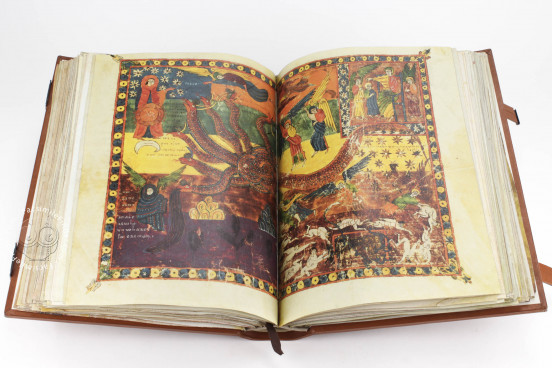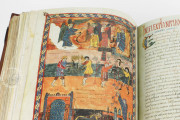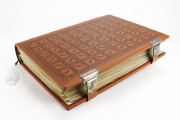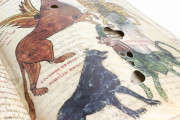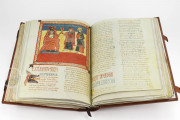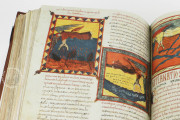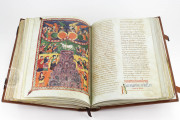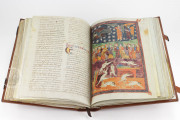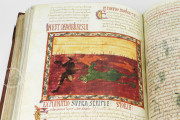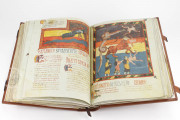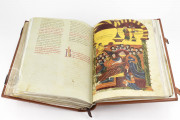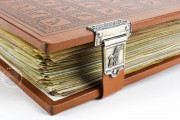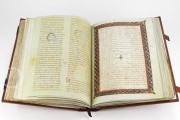The Valladolid Codex—also known as the Valcavado Codex—is an illuminated copy of Beatus of Liébana's allegorical commentary on the Apocalypse, the last book of the Christian Bible. Created in the Kingdom of León in 970 and famous for its expressive paintings, it opens with a pair of pages that feature a cross and an acrostic declaring the manuscript's ownership by Abbot Sempronius (fols. 1v-2r). The text proper features seventy-one illustrations of the Apocalypse and ten illustrations of Saint Jerome's commentary on the prophecy of Daniel.
The manuscript was signed by its illuminator, Obeco, who may also have been one of its scribes. Obeco's paintings, whether miniatures or vignettes, are brilliantly colored in a palette dominated by blue, red, green, rusty orange, and yellow.
Obeco, Painter and Scribe
One of the manuscript's colophons reports that one Obeco painted the book (fol. 2v) and another reports that Obeco wrote it (fol. 230v). The text is manifestly the work of more than one scribe, though, and scholars have debated the extent and nature of Obeco's contribution. The illumination appears to be the work of a single artist, and Obeco may have both illuminated the book and supervised the writing, whatever the extent of his own scribal activity.
One Illuminator, Three Approaches
Although the work of a single artist, the illumination changes in structure for each section of the manuscript. The opening pages are dominated by their elaborate frames with intricate interlaced knots at the corners (fols. 1v-2r). The scenes of Saint John the Divine's vision of events leading to the end of time—including cataclysms involving monstrous creatures and fire—are mostly presented in miniatures with painted frames, whereas the illustrations of Daniel's prophecy feature figures silhouetted against the unpainted parchment surface.
Double-Page Miniatures
Among the miniatures illustrating the Apocalypse, three fill two facing pages: a mappa mundi (fols. 36v-37r), the Woman Clothed in the Sun (fols. 130v-131r), and the Last Judgment (fols. 180v-181r). Another miniature extends across the gutter onto the facing page (fols. 134v-135). In the representation of the great angel with one foot on the sea and the other on the earth (fol. 123v), the sea—depicted full of fish—extends from the page's outer margin into the miniature.
Iberian Script
The Latin text is written in the idiosyncratic script of the Iberian Peninsula, Visigothic Minuscule. According to one of the colophons (fol. 3v), the writing took three months to complete. The abundant explanatory inscriptions that accompany the paintings are in display capitals employing many of the characteristic features of Iberian writing.
An Early Modern Encounter with the Manuscript
The historian Ambrósio de Morales (1513-1591) saw the manuscript at the monastery of Valcavado, which has led some to speculate that it was made there. Probably at Morales's behest, the manuscript was taken to León, where it could be compared to the later Facundus Codex. By the early seventeenth century, the codex was at the Colegio de San Ambrosio in Valladolid.
_____
For more information on the Beatus model, read our blog article by Amy R. Miller (PhD, Medieval Art History, University of Toronto).
We have 1 facsimile edition of the manuscript "Beatus of Liébana - Valladolid Codex": Beato de Valcavado facsimile edition, published by Testimonio Compañía Editorial, 2000
Request Info / Price
